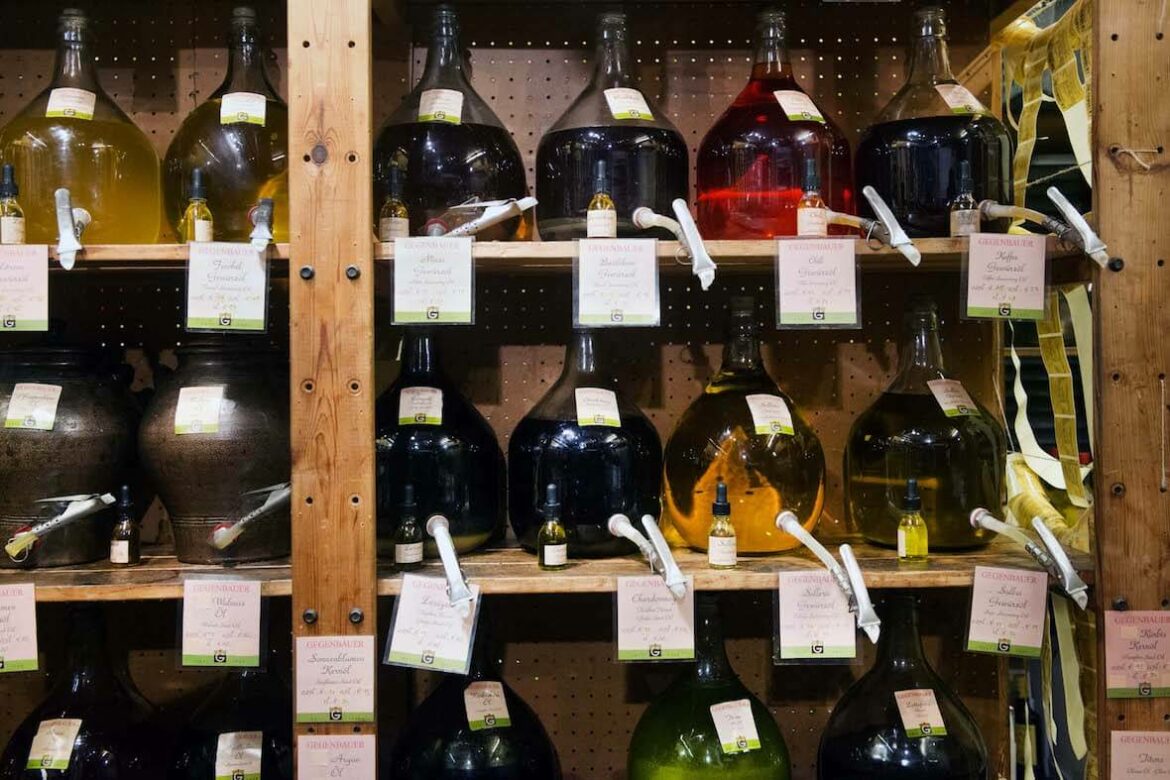
The surname “Gegenbauer” has echoed in my head for 15 years. Ever since that first sip of his Noble Sour PX, I’ve been waiting to visit Vienna in hopes of meeting the man who quite possibly makes the best vinegar in the world.
I first tried it as a young cook in Boston when my chef handed me a capful of the sherry vinegar made with Pedro Ximénez (PX) grapes and told me it would change my life. I was used to this kind of exaggerated kitchen parlance, expecting my body to recoil and hack from the acidity. Instead I realized then that, in fact, all the vinegars I had ever tasted until this point were for naught. It was bright but also balanced, round and unlike anything I had ever had. This was the one sip that inspired me nearly a decade later to take my own acid trip, you could say, to study vinegars around the globe.
But first, what exactly is vinegar? For the past half-century, we Americans have embraced a zingy liquid called as much in its perfunctory supermarket incarnation. Most of what we see on the grocery shelves is made of industrial grains, converted into a basic ethanol, then force-fermented into serviceable vinegar through the use of acetators that speed the process up 100-fold for efficiency’s sake. As someone who’s now written a book about vinegar, I wouldn’t call this product more than a flavor-infused mixture.
Real vinegar, technically a weak acid, is 4 to 6 percent acetic acid in solution (water), made through the fermentation of ethyl alcohol by the wonder of Acetobacter (a genus of acetic acid bacteria). I believe it’s best made slow-and-low like barbecued meats. It’s also a sort of fine wine that takes even more time and patience to bring it to a gentle and round acidic liquid full of nuanced aroma—not just a burning sensation and nail polish smell you get with industrial brands.

So on my quest to frosty Vienna in the winter of 2015, I woke up in an overnight sleeper car doing as Freud might: I remembered my first taste of an acidic vinaigrette, making a season’s stock of bracingly sharp pickles to last all winter, deglazing a meaty pan sauce or curdling milk and cream to make ricotta. These sapid memories are the reasons I was traveling to meet and give a voice to one of vinegar’s most brilliant makers.
Erwin Gegenbauer began his acetic acid experiments as an alternative, if not in opposition, to schnapps, a potent local libation that’s essentially a flavored neutral grain spirit. He’d had it with drinking such high-spirited liquors, substituting his own concoctions as aperitifs and digestifs. His vinegars have purity to them, as their ingredients are rarely more than the substance itself (e.g., asparagus, Aronia berry, red pepper), and he also makes enchanting wine vinegars from regional grapes like Trockenbeerenauslese and riesling. His products achieve a sense of place, or a vinegar terroir, if you will.
I first found Gegenbauer at his residence, on the western side of the city along the Danube River, which is also used as a storefront. I had imagined I’d find a Willy Wonka type whose mad creations are made in a funhouse laboratory, but the Wiener Essig Brauerei (Viennese Vinegar Brewery) was quite the opposite. His gangly frame and gregarious nature were already in entertaining mode, warmly serving me freshly baked bread, house-cultured butter and homebrewed beer like I’d just been taken in by a modern day Swiss Family Robinson. Obviously handmade wooden shelves were stocked with so many vinegars of a thousand tinges, all available to sample. There was a chicken coop on the roof next to the balsamic vinegar barrels. The entire space was calculated, every utilitarian detail punctuated by years of his distinct personal flare. I had encountered a master of his craft in a space reflecting years of contemplation.
After a tour and tasting, I followed Gegenbauer to his outpost at the Naschmarkt, a marketplace with more than 100 stalls of food vendors and restaurants that stretches a mile down Wienzeile (Vienna Row). There, he displays rows of demijohns (oblate glass jars) with spigots to fill ornately ridged glass bottles. My encounter was an acidic epiphany, every single sip of Gegenbauer’s work resulted in a visceral encounter with millennia-old culinary art. Each of his vinegars is a unique expression turned awakening—a dream for vinegar to be rejoiced rather than overlooked. Each coats the tongue, tenderly persuading the palate to ask for more.
Since my first taste of his Noble PX back in Boston, I have become a vinegar maker myself. Taking what I’ve learned, I’ve been brewing batches of seasonally inspired ingredients at home for years, using honey (mead), malt (beer) and even Concord grapes (wine) as a base. First, thanks to Gegenbauer’s craft, and as a result of my own research and experimentation, I’ve come to realize that better forms of acidity are available if we want them—as I learned on my journey, it just takes time and patience.
Based in Brooklyn, and the founding photo editor of this magazine, Michael Harlan Turkell is the author of the recently released Acid Trip: Travels in the World of Vinegar: With Recipes from Leading Chefs, Insights from Top Producers, and Step-by-Step Instructions on How to Make Your Own.



